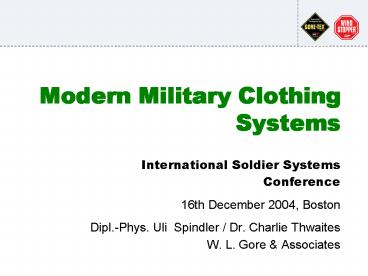International Soldier Systems Conference - PowerPoint PPT Presentation
1 / 19
Title:
International Soldier Systems Conference
Description:
thermal discomfort is signal of thermal imbalance. perception of discomfort varies greatly on situation. further imbalance: heat or cold strain ... – PowerPoint PPT presentation
Number of Views:56
Avg rating:3.0/5.0
Title: International Soldier Systems Conference
1
Modern Military Clothing Systems
- International Soldier Systems Conference
- 16th December 2004, Boston
- Dipl.-Phys. Uli Spindler / Dr. Charlie
ThwaitesW. L. Gore Associates
2
Thermal comfort zone
- the body needs to stay in narrow temperature
limits - comfort range about 37C 0.5C (core
temperature) - exceeding these discomfort starts
- thermal discomfort is signal of thermal imbalance
- perception of discomfort varies greatly on
situation - further imbalance heat or cold strain
- finally casualty due to hypothermia or
hyperthermia
3
Heat Balance
- Balance between
- heat production of the body
- depends on activity level
- typically ranges from 150 W (standing) to
450 W (marching 5 km/h carrying 30 kg) - heat loss to ambient
- depends on ambient conditions
- temperature, precipitation, wind
4
Temperature control
- Hot side
- sweating and vasodilatation
- evaporating 1 litre sweat per hour 670 W heat
loss - automatic behavioural changes
- clothing adaptation (rolling up sleeves, taking
off layers) - reducing activity level (e.g. going slower)
- Cold side
- vasoconstriction
- shivering to increase heat production
- warmer clothing
5
Heat balance overview
Ambient Temperature Humidity Precipitation Wind Ra
diation
Activity Physical power Duration
Clothing Thermal Insulation (Rct) Waterproofness W
indproofness Breathability (Ret) Ventilation
Person Gender Size and weight Fitness Age
Body core temperature Sweat rate
Comfort Performance
6
Thermal insulation and moisture
- Wet insulation
- Rct reduced by about 50 to 70
- liquid moisture is good enough for effect
7
Windproofness and air permeability
- Air permeability
- measures how easy air penetrates fabrics
- expressed in l/s/m² at 100 or 200 Pa
- Windproof
- air permeability according to EN342
- class 3 current lt 20 l/s/m² at 100 Pa
- class 3 future lt 5 l/s/m² at 100 Pa
8
Windproofness and wind speed
Underwear Fleece Shell Global resistance,
excluding extremities
0.450
0.400
0.350
0.4 m/s (Oulu)
0.300
2 m/s (Oulu)
0.250
4 m/s (Oulu)
Total thermal resistance Rct (m²K/W)
8 m/s (Cord)
0.200
10 m/s (Oulu)
0.150
15 m/s (Oulu)
0.100
0.050
0.000
20
5
0.1
1
10
100
1000
10000
shell air permeability (l/m²/s)
9
Breathability
- Ret - evaporative resistance of a textile
- measured on the skin model according to ISO 11092
- expressed in m²Pa/W
- thickness again is a main influence
- high insulation always has a high Ret
- Breathability needs always to be as high as
possible to keep heat strain as low as possible
10
Missed signals per minute of exposure
Source P. A. Hancock, Psychological Bulletin,
1986, Vol. 99, no2 p. 263-281
11
Heat Casualties vs. Core Temperature
12
Walking speed for the same heat strain carrying
30 kg
13
Clothing system evaluation
According to
Level Four Controlled and limited Field test
Predictive Calculations
Level Three Controlled wearer tests with
subjects in a Climatic Chamber
Level Two Biophysical analysis of clothing
systems using moving thermal manikin.
Predictive Calculations
Level One Physical analysis of fabrics using
the Sweating hot plate ( ISO 11092, CEN 31092 )
and Sensorial tests
14
ISO 11 092 (Skin Model)Ret and Rct measurement
- Rctresistance to conductive heat transfer
- Ret resistance to evaporative heat transfer
- the smaller the value the more vapour permeable
the fabric
15
Manikin testing
- life size manikin
- heated
- articulated
- measurement of thermal insulation
- calculation of evaporative resistance
- few sweating manikins available
16
Ventilation on humans
- Ventilation rate
- manikin dont move natural? values too small
- we bought a system to measure real ventilation
rates on humans carrying out realistic activities
17
climatic chamber trials with human subjects
- Confirmation of predictions
- Measurement of
- Work rate
- body core temperature
- skin temperature
- heart rate
- subjective ratings
- perceived exertion
- comfort
- etc
18
Controlled Field Trials
- Minimum requirements according to ACCP 1
- measurement of ambient factors
- monitor physiological factor
- standardised activities
- standardised clothing assemblies
- energy expenditure analyses
19
Summary
- Well designed modern clothing systems can greatly
increase the performance and operational
effectiveness of soldiers - All layers and materials of a clothing ensemble
have to fit and work together for optimal
performance of soldier systems - Proper design and evaluation of systems requires
know how and experience

